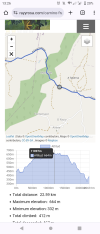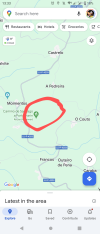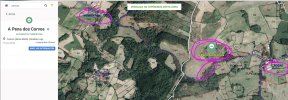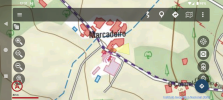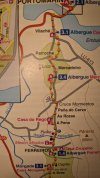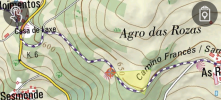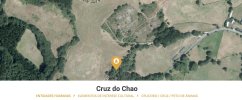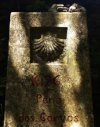Have you heard of Pena dos Corvos? It is supposed to be a high point (660m) before Portomarin. Google Maps can find four Penas dos Corvos on the north coast of Galicia, but not on the CF. A lot of the camino references are suspiciously similar:
The Camino ascends to a high point at Pena dos Corvos; at 660m you will enjoy panoramic views, (Macs Adventure), (Second Life Outdoors) and (Bergfex)
The. Camino ascends to a high point at Pena dos Corvos. At 660m, we will enjoy fantastic panoramic views (Nativity Pilgrimage)
We reach the high point of the day at Pena dos Corvos (660m)! (Pathfinders.me)
Pena dos Corvos 660m at Cruce Momientos [1.3 km] with fine views (Brierley) -- Google Maps doesn't know where Cruce Momientos is either.
Pity of the Crows is the translation from Galician -- seems an odd name to give to a place, but something may have been lost in translation. I don't expect that there is a sign saying "Pena dos Corvos", but, if there isn't, how did all these bloggers know that they were there? So, can you give me the co-ordinates for Pena dos Corvos on the Camino Francés?
The Camino ascends to a high point at Pena dos Corvos; at 660m you will enjoy panoramic views, (Macs Adventure), (Second Life Outdoors) and (Bergfex)
The. Camino ascends to a high point at Pena dos Corvos. At 660m, we will enjoy fantastic panoramic views (Nativity Pilgrimage)
We reach the high point of the day at Pena dos Corvos (660m)! (Pathfinders.me)
Pena dos Corvos 660m at Cruce Momientos [1.3 km] with fine views (Brierley) -- Google Maps doesn't know where Cruce Momientos is either.
Pity of the Crows is the translation from Galician -- seems an odd name to give to a place, but something may have been lost in translation. I don't expect that there is a sign saying "Pena dos Corvos", but, if there isn't, how did all these bloggers know that they were there? So, can you give me the co-ordinates for Pena dos Corvos on the Camino Francés?
Last edited:







